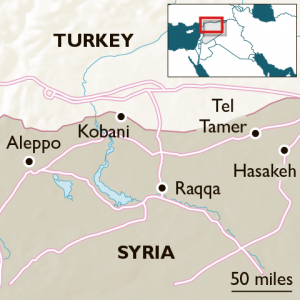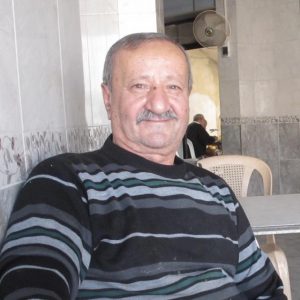By Richard Spencer – The Times (UK) –
 The 35 Christian villages of the Khabur Valley echo emptily. Some are burnt and others just deserted, their mud-brown houses settling back into the desert hills.
The 35 Christian villages of the Khabur Valley echo emptily. Some are burnt and others just deserted, their mud-brown houses settling back into the desert hills.
Six years ago, this was one of the last rural communities of the Assyrian Christian population of Syria. Around 20,000 of them lived along its banks, their villages marked out by elaborate churches and monasteries.
Now just a handful of families remain, surviving largely on handouts from émigré relatives in the West. Some stay because they cannot leave. “I am, of course, praying that my daughter is still alive somewhere,” says Abu Elias, in the courtyard of a squatted house in the town of Tel Tamer.
His own was destroyed by Islamic State. The story of how that happened is banal by jihadist standards and it passed almost without notice, but it has been catastrophic for the villagers.
They are poor by the standards of Syria’s Christians, who are mostly identified with the bourgeois elites of Aleppo and Damascus. Here in the northeast, near the city of Hasakeh, they are just one sect of many scratching a living in a tough, dry region.
Generally loyal to the regime and living among Kurds and Arabs, they found that there was no one to protect them when war came.
In February 2015, as the world watched the battle for Kobane, two hours to the northwest, Isis moved up the valley from Raqqa. “They arrived in the village at six in the morning,” Abu Elias said. “They took everyone, even the babies. They gathered us in the village square, firing into the air to frighten us. Then they drove us off.”
The 140 people kidnapped from his village, Tel Jazira, were joined by others: altogether, 236 Christians were seized and held first in the town of Shedadeh and then in Raqqa itself.
The aim was simple: not to convert them — though they were offered that choice, by Jordanian and Saudi imams brought to see them. The aim was cash.
Six men were taken to make a ransom video. Three were told to pretend to be shot when the video started, with the others asking to be rescued. The three actors were, in fact, shot dead as the camera ran. “We had to make it realistic,” the militants said.
They were the only three of the hostages to be killed. The others were ransomed after a year, the international Assyrian community raising a reported $11 million to buy them back. All except one. One day, Isis guards entered the house where the women and families were held and chose five girls and young women, including Abu Elias’s 12-year-old daughter, Carolyn.
They were made to convert by reciting the Muslim Shahadah — declaration of faith — at gunpoint, and were taken away to perform an unspecified “duty”. The next day four were returned, their hair apparently too short.
But Carolyn has not been seen since, and all Abu Elias can do is wait for news with his wife and five other children.
For the other captives, there was no reason to return to their destroyed villages. Most Christians in this part of the world have relatives in the West, and sympathetic governments could hardly deny their persecution.

Younadan Nuya Warda has seen his family and friends scattered around the world
All but two of the captive families have left Syria, along with most of the rest of the community. “At weddings, there used to be 450 families from Tel Tamer alone,” said Younadan (Jonathan) Nuya Warda, 67. “Now there are 50 in the whole valley.”
He runs a felafel and hummus shop near a secondary school, where generations of teenagers have snacked during break times. His brothers have all left: one, a teacher, is in Sweden; the policeman is in Canada; the butcher is in Australia. All work as waiters.
There has been much talk of the Christians’ persecution in the Middle East’s wars, which is undeniable, but the story is also contradictory. They have suffered fewer deaths than Sunni, Shia or Alawites, and have not — mostly — faced mass murder. There were Christians living in Raqqa until earlier this year, paying jizya — “non-Muslim” tax.
But the greater readiness of the West to accept them than Muslims, in practice if not in policy, has been a devastating lure to a community that even outside the war was victimised.
The Christian population of Syria has roughly halved from a pre-war 1.7 million. Those who remain are concentrated in the big cities, meaning remnants of ancient settlements, such as those along the Khabur, will soon die off.
______________________
Photo: Much of Raqqa lies in ruins, as do countless towns and cities across Syria — among them many small Christian settlementsBULENT KILIC/AFP/GETTY IMAGES
https://www.thetimes.co.uk/edition/world/syrias-christians-driven-to-theedge-t9lx8rj6f





